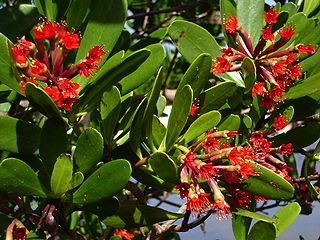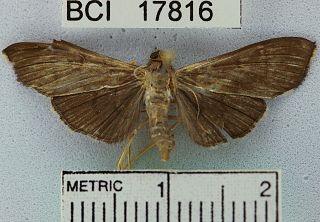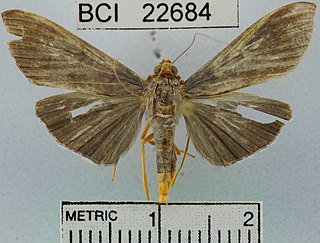
The Myrtales are an order of flowering plants placed as a sister to the eurosids II clade as of the publishing of the Eucalyptus grandis genome in June 2014.

Teak is a tropical hardwood tree species in the family Lamiaceae. It is a large, deciduous tree that occurs in mixed hardwood forests. Tectona grandis has small, fragrant white flowers arranged in dense clusters (panicles) at the end of the branches. These flowers contain both types of reproductive organs. The large, papery leaves of teak trees are often hairy on the lower surface. Teak wood has a leather-like smell when it is freshly milled and is particularly valued for its durability and water resistance. The wood is used for boat building, exterior construction, veneer, furniture, carving, turnings, and other small wood projects.

Omiodes is a moth genus in the family Crambidae. Several species are endemic to Hawaii.

Omiodes diemenalis, the bean leafroller, is a moth in the family Crambidae. It was described by Achille Guenée in 1854. It is found in Indonesia, Sri Lanka, India, the Cook Islands, China, Thailand, Papua New Guinea and Australia, where it has been recorded from the Northern Territory, Queensland and Tasmania.

Omiodes humeralis is a moth in the family Crambidae. It was described by Achille Guenée in 1854. It is found in Haiti, the Dominican Republic, Puerto Rico, Honduras, Panama, Costa Rica and Argentina.
Omiodes simialis is a moth in the family Crambidae. It was described by Achille Guenée in 1854. It is found in Brazil, Venezuela, French Guiana, the West Indies, Honduras, Costa Rica and Florida.
Omiodes origoalis is a moth in the family Crambidae. It was described by Francis Walker in 1859. It is found in Indonesia and north-eastern India.
Omiodes poeonalis is a moth in the family Crambidae. It was described by Francis Walker in 1859. It is found in the Democratic Republic of the Congo, Sierra Leone, Tanzania, the Chagos Archipelago, China, Indonesia, Sri Lanka, Japan and Australia (Queensland).
Omiodes surrectalis is a moth in the family Crambidae. Described by Francis Walker in 1866, it is found in the Democratic Republic of the Congo, India, Indonesia, the Philippines, Sri Lanka, New Guinea and Queensland, Australia.

Omiodes fulvicauda is a moth in the family Crambidae. It was described by George Hampson in 1898. It is found in Venezuela, Costa Rica and Panama.
Omiodes hallwachsae is a moth in the family Crambidae. It was described by Patricia Gentili-Poole and Maria Alma Solis in 1998. It is found in Costa Rica. It was named in honor of biologist Winifred Hallwachs.
Omiodes insolutalis is a moth in the family Crambidae. It was described by Heinrich Benno Möschler in 1890. It is found in Puerto Rico and Costa Rica.
Omiodes martyralis is a moth in the family Crambidae. It was described by Julius Lederer in 1863. It is found in Argentina, Venezuela, Brazil, Puerto Rico, Costa Rica and Mexico.
Omiodes nipponalis is a moth in the family Crambidae. It was described by Hiroshi Yamanaka in 2005. It is found in Japan (Kyushu) and China.
Omiodes nitida is a moth in the family Crambidae. It was described by George Hampson in 1912. It is found in Colombia and Costa Rica.

Omiodes noctescens is a moth in the family Crambidae. It was described by Frederic Moore in 1888. It is found in India, China Korea, Japan and Taiwan.
Omiodes rufescens is a moth in the family Crambidae. It was described by George Hampson in 1912. It is found in the Bahamas and the United States, where it has been recorded from Florida.
Omiodes similis is a moth in the family Crambidae. It was described by Frederic Moore in 1885. It is found in Sri Lanka and China.
Omiodes niphoessa is a moth in the family Crambidae. It was described by Jean Ghesquière in 1942. It is found in the Democratic Republic of the Congo.
Omiodes pernitescens is a moth in the family Crambidae. It was described by Charles Swinhoe in 1894. It is found in Meghalaya, India and China.







